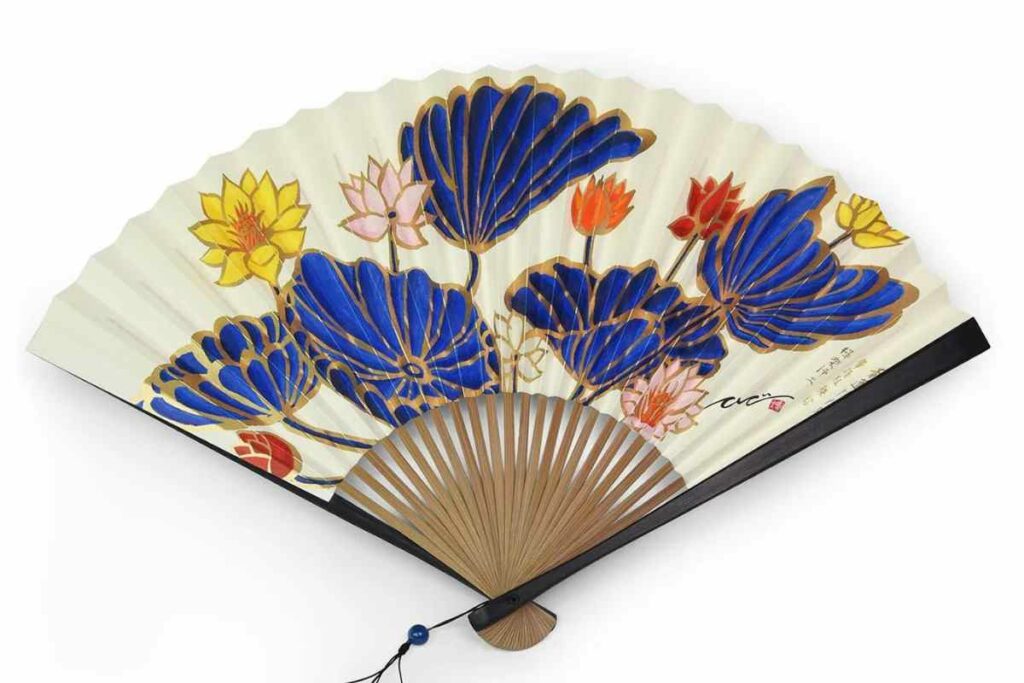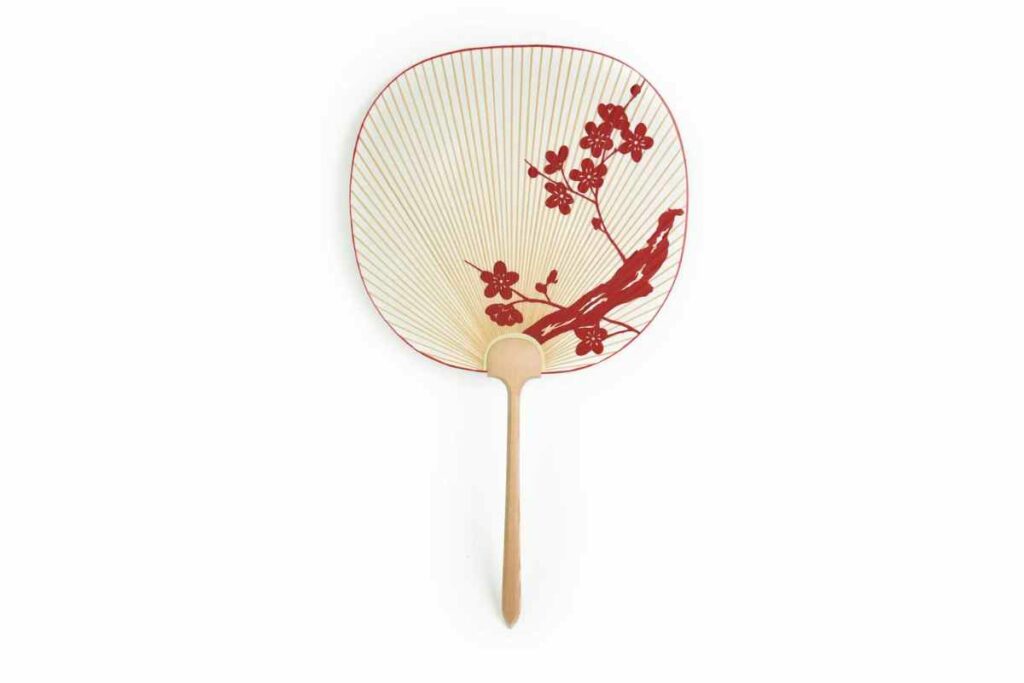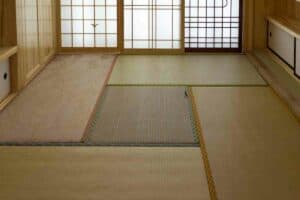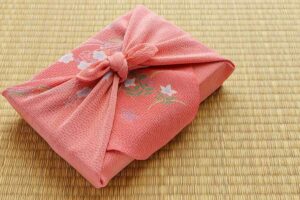Japan is known for its iconic fans that are not only a practical solution for the summer heat but also exquisitely beautiful.
There are several types of Japanese fans that have been in existence since the 9th century and continue to be used to the present day.

Take a look at these 14 gorgeous Japanese fans, including some stunning and 100% authentic designs you can buy.
Table of Contents
12 Traditional Japanese Fans
For the Japanese, a fan is a portable form of beauty that enhances any environment.
Many Japanese fans are collector’s items and antiques, with some sold for thousands of pounds or exhibited in museums.
Read later – 7 Amazing Japanese Fan Facts
Here are some outstanding examples of traditional Japanese fans:
12. Antique Japanese Hand Fan
Japanese folding fans for women have an instantly recognizable design that is recognizable around the world.
Though other cultures have similar folding fan designs, it is the ornate decoration of the paper or silk of the fan that is distinctly Japanese. The folding fan is believed to have originated in Japan.
11. Exquisite Japanese Folding Fan
Folding hand fans are called sensu (伊場仙) or ōgi (扇). They are still made according to a 7th-century design, with strips of cypress or bamboo threaded together.
Folding fans were initially the preserve of the nobility, samurai, and priests, with elaborate etiquette surrounding their use. These fans could also be used to communicate messages.
10. Types of Japanese Fan
There are three types of Japanese folding fan:
- The hiōgi, which is a wooden folding fan that uses 1 inch strips of cypress or fragrant cedar stitched tog
- Paper folding fans known as kamisen which use washi paper, a special type of Japanese paper.
- Silk folding fans are called kinusen.
9. Hiōgi Japanese Fan
Japan’s folding fans originated in Japan and featured pasted paper on just one side of the fan.
These fans were exported to China in the 10th century and were called ‘wasen’ by the Chinese. Soon the practice of pasting paper to both sides of the fan ribs was adopted.
In the 19th century, Japan began mass exports of its folding paper fans to the Americas.
The intricate decoration and vibrant colors made them very popular and they remain sought after throughout the world.
8. Kyoto-made Folding Fan

This delightful folding hand fan is handmade in Kyoto.
It features artwork by the contemporary artist Hideki Kimura and is made from washi paper and sandalwood. More images on shop.japanobjects.com
7. Traditional Uchiwa Fans
The uchiwa is another popular Japanese hand fan design that is still popular for keeping cool in the humid summer in cities like Tokyo.
The traditional uchiwa is made using bamboo and paper that has been dyed with a fermented kaki juice dye known as kakishibu. Traditionally made uchiwa can last a long time.
6. Kyoto-Style Uchiwa

Buy this stunning and 100% authentic Kyo-Uchiwa, a Kyoto-style uchiwa that has been made in the city by craftsmen at Aiba since 1689. More images on shop.japanobjects.com
5. Hand-Painted Japanese Fans
High-quality Japanese fans are routinely hand painted.
Craftsmen who continue to make the fans can produce custom designs that include your name or special meaning.
Uchiwa fans from Kyoto are some of the finest with small shops that have been making them for centuries and even supplying the Imperial court.
4. Marugame uchiwa
The Marugame uchiwa is a distinctive type of uchiwa that has been made in and around Marugame, Kagawa prefecture since the 17th century.
They were initially made as a souvenir for pilgrims but became widely produced by samurai.
This folk design features a handle and frame that are made from one piece of bamboo with a flat or rounded handle.
3. Making an Uchiwa
Uchiwa are made by cutting and splitting bamboo to make a handle and frame, drilling a hole, carving patterns into the fan, entwining thread on the bamboo frame, adjusting the fan to become symmetrical, pasting paper over the head of the fan and cutting it into shape.
The uchiwa is finished with glued paper edging to secure it, then pressed flat with a roller.
2. Boshu Uchiwa
This is an uchiwa from Chiba Prefecture called the Boshu Uchiwa.
This traditional form of uchiwa is made from medake (Japanese timber) bamboo with a ‘maru-e’ round handle and delicate bamboo ribs.
This form of uchiwa has been made in Chiba since the 19th century, with many workshops where you can learn to make them throughout Chiba using folk craft patterned fabric.
1. Geishas and Fans
The geisha tradition has a longstanding relationship with fans that are used for demure communication, veiling emotions, and artistic performance.
Since 2020. Geishas have been trained to use fans to cover their mouths during conversations to prevent the spread of COVID-19. The fan is usually carried by the geisha in her bag, called a kago.
Traditional Japanese Fans FAQs
What is Japanese fan dancing?
Did Samurai carry fans?
Rounding Up
Japanese fans have a long history of craftsmanship, with master fan makers continuing to the present day.
A Japanese folding fan or uchiwa is a gorgeous accessory that will elevate any outfit and can be kept as a collectors item, due to its uniqueness and quality.
- Best Japanese Knives Top Picks for Every Kitchen
- Japan’s Bold New Trend: Dressing Like a British Gentleman (or at Least Trying)
- 7 Best Japanese Sunscreen Products You Can Buy Online
- 5 Best Japanese Makeup Brushes for a Flawless Finish
- 7 Benefits Of Tatami Mats You Should Know
- The Best Furoshiki Wrapping Cloths: Inspiration, Ideas & Cloths You Can Buy









